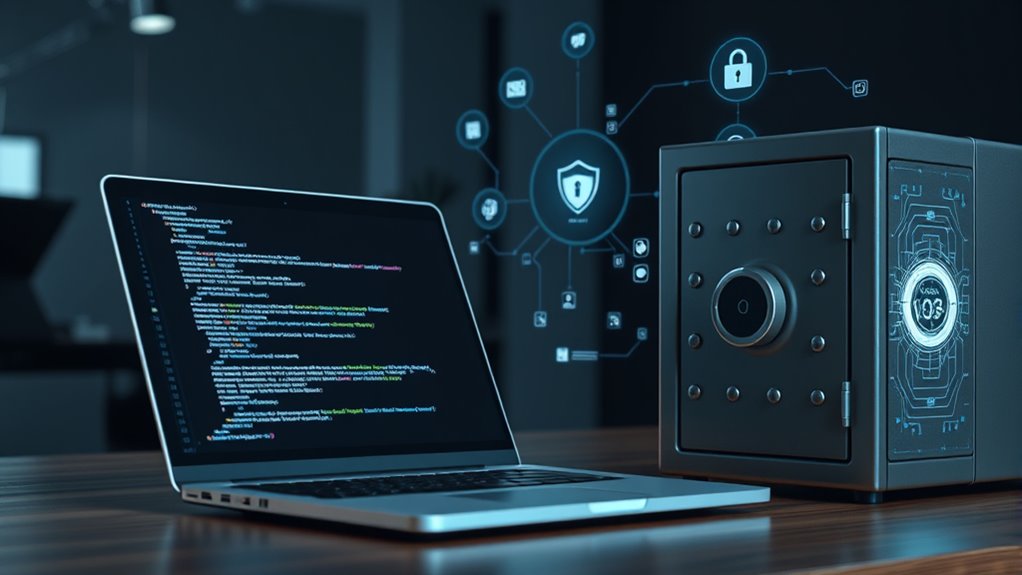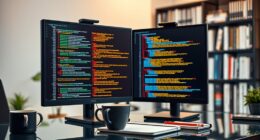In the era of AI assistants, securing your code starts with implementing strong access controls, like multi-factor authentication and clear permissions, to limit who can view or modify sensitive parts. Combine this with code obfuscation to make reverse engineering harder for AI tools and malicious hackers. Regularly update your security measures and review access rights to stay ahead of evolving threats. Staying proactive helps minimize risks—more insights on how to enhance your defenses follow.
Key Takeaways
- Implement code obfuscation to make reverse engineering by AI tools more difficult.
- Enforce strict access controls and multi-factor authentication to limit code exposure.
- Regularly update security measures to counter evolving AI-driven threats.
- Combine obfuscation with layered security strategies for comprehensive protection.
- Educate teams on best practices to maintain secure code management in AI-enhanced environments.

Have you ever considered how vulnerable your code might be to cyber threats? In today’s digital landscape, hackers are constantly finding new ways to exploit vulnerabilities, making it essential for you to protect your intellectual property and sensitive data. One effective method to deter reverse engineering and tampering is code obfuscation. By transforming your code into a more complex, less readable form, you make it considerably harder for attackers to understand and manipulate your software. Obfuscation doesn’t prevent all attacks but acts as a key obstacle that slows down malicious actors, buying you valuable time to respond.
Alongside code obfuscation, implementing robust access control measures is indispensable. Access control ensures that only authorized individuals can view or modify your code, whether it’s stored in repositories, shared among team members, or deployed in production environments. You should define clear user roles and permissions, limiting access to sensitive parts of your codebase. Multi-factor authentication adds an extra layer of security, making it more difficult for unauthorized users to gain entry, even if they have obtained login credentials. Remember, even a small breach can have serious repercussions, so tight access controls are your frontline defense.
Implement robust access controls and multi-factor authentication to protect your code from unauthorized access.
In an era where AI assistants can analyze and generate code rapidly, protecting your source code becomes even more essential. These tools can be a double-edged sword—helping you develop faster but also making it easier for malicious actors to understand your logic if your defenses are weak. Properly obfuscating your code ensures that AI-based analysis doesn’t easily reveal proprietary algorithms or security flaws. Meanwhile, access control limits who can feed your code into these AI assistants, reducing the chances of unintentional leaks or misuse. Employing advanced security techniques can further reinforce your defenses against sophisticated threats. Additionally, understanding the role of vulnerabilities in your code can help you prioritize which areas need more robust protection, especially considering the influence of technology like AI on security risks.
Additionally, combining code obfuscation with secure access controls creates a layered defense strategy. If one layer is compromised, the other still offers protection. For instance, even if an attacker gains temporary access to your code repository, obfuscation makes it difficult for them to reverse engineer the code’s intent or discover vulnerabilities. Conversely, strong access controls prevent unauthorized access in the first place, limiting potential damage. Staying updated on security best practices and regularly reviewing your defenses further enhances your protection against evolving threats.
Ultimately, safeguarding your code requires proactive measures. Regularly updating your obfuscation techniques and reviewing access permissions can help you stay ahead of evolving threats. In a world increasingly influenced by AI, your best defense is to make your code as complex and protected as possible, ensuring that your innovations remain secure and under your control.
Frequently Asked Questions
How Can I Detect Ai-Generated Code Vulnerabilities?
To detect AI-generated code vulnerabilities, you should start with thorough code reviews, focusing on areas where AI tools might introduce risks. Use vulnerability scanning tools to identify potential flaws or insecure patterns. Keep an eye out for unusual or inefficient code, and test extensively. Combining manual review with automated scanning helps you catch vulnerabilities early, ensuring your code stays secure despite the complexities AI-generated code can introduce.
Are There Tools to Verify AI Code Suggestions?
Think of verifying AI code suggestions like a lighthouse guiding ships through fog—you need reliable tools. Yes, automated code review tools exist that help verify AI-generated code for vulnerabilities, ensuring safety. They act like an extra set of eyes, catching potential issues you might miss. Additionally, investing in developer training helps you better assess AI suggestions, making you more confident in integrating AI into your workflow effectively and securely.
How Do I Prevent AI From Exposing Sensitive Data?
To prevent AI from exposing sensitive data, you should implement strong access controls, limiting who can access your code and data. Use code obfuscation techniques to make your code harder to read and reverse-engineer. Regularly audit your systems for vulnerabilities, and avoid sharing sensitive information during AI interactions. These steps help secure your data and reduce the risk of accidental exposure by AI assistants.
Can AI Assistants Learn From My Private Code?
You might wonder if AI assistants can learn from your private code. While many AI systems use data for training, reputable providers prioritize code privacy and implement strict safeguards. However, if your private code is shared with an AI, it could be used in AI training, risking exposure. To protect your code privacy, always review the AI’s data policies and avoid sharing sensitive code unless you’re certain it won’t be used for AI training.
What Legal Issues Arise From Ai-Assisted Coding?
You might find it surprising, but AI-assisted coding raises key legal issues. When you rely on AI, you could unintentionally infringe on someone’s intellectual property, especially if the AI uses protected code snippets. Liability concerns also emerge if bugs or security flaws cause damages. You need to comprehend these risks and ensure proper licensing and compliance, protecting yourself from potential legal disputes in this rapidly evolving tech landscape.
Conclusion
As you navigate the AI-assisted coding landscape, remember that safeguarding your code is the shield that guards your digital castle. Stay vigilant, adopt best practices, and keep your defenses strong. Think of security as the steady drumbeat behind your innovations—steady, dependable, essential. By proactively protecting your work, you ensure your creations remain safe in the ever-evolving world of AI. Keep your guard up, and let security be the anchor that keeps your code afloat.









